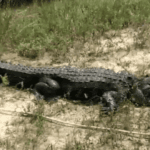Alligator gars, with their prehistoric appearance and sharp teeth, often evoke a sense of awe and fear. But how much of what we hear about their bite is rooted in reality? This article dives deep into the world of alligator gar, separating fact from fiction, and providing anglers and nature enthusiasts with the knowledge they need to appreciate and respect these ancient fish.
Debunking the Myths: Are Alligator Gar Bites Common?
Let’s address the elephant in the room—or rather, the gar in the water. While their powerful jaws and razor-sharp teeth might suggest otherwise, alligator gar bites on humans are incredibly rare. These fish have been sharing waterways with humans and other creatures for millions of years. Their bite force, while not definitively measured, is primarily designed for their diet of fish and crustaceans, employing a strategy of piercing, tearing, and thrashing—not crushing.
The majority of reported alligator gar bites happen when the fish feels threatened or cornered, particularly during handling. Imagine yourself being wrestled with and having a sharp object stuck in your mouth—wouldn’t you try to break free?
Alligator Gar Teeth: A Closer Look at Evolutionary Engineering
To understand the nature of an alligator gar bite, it’s essential to understand their remarkable teeth.
Needle-Sharp Design: Alligator gar teeth are designed for piercing and holding prey. Their upper jaw boasts two rows of these sharp teeth, while the lower jaw has a single row, ensuring a secure grip on their slippery meals.
Built for Speed and Power: Their elongated snout isn’t just for show—it’s a crucial part of their hunting technique. This streamlined shape facilitates lightning-fast strikes, allowing them to ambush prey with impressive speed.
Jaw Muscles Made for Thrashing: While their bite force remains a subject of debate, there’s no denying the power behind those jaws. Alligator gars are known for their vigorous thrashing motions once they’ve latched onto prey, using their jaw muscles to tear and rip their meals apart.
Alligator Gar Behavior: Understanding the Triggers
Knowing how alligator gars behave in their natural environment can help us coexist safely and responsibly.
Ambush Predators: Alligator gars are masters of disguise, preferring to lie in wait for unsuspecting prey rather than actively chase it down. Their camouflaged bodies and patient nature make them highly effective hunters.
Opportunistic Feeders: While their diet consists primarily of fish and crustaceans, alligator gars are opportunistic feeders. This means they might strike at anything they perceive as potential prey, especially if it’s splashing around in their territory—a good reason to be mindful of our movements in their habitat.
Not Out to Get You: Despite their fearsome reputation, there’s no evidence to suggest that alligator gars actively seek out humans as prey. We are simply too large and agile to be on their menu. Encounters usually only occur when the fish feels threatened or its space is being invaded.
Responsible Fishing Practices: Respecting the Ancient Ones
For anglers lucky enough to encounter these living fossils, responsible fishing practices are paramount. Here’s how to ensure a safe and ethical experience for both you and the fish:
Handling with Care: Use specialized grip pliers to handle alligator gar, minimizing the risk of injury to yourself and the fish. Avoid touching their mouths or putting yourself in a position where you could be bitten.
Releasing with Respect: Once you’ve admired your catch, it’s crucial to release the alligator gar back into the water as quickly and safely as possible. Hold the fish gently, supporting its weight, and allow it to swim away under its own power.
Conservation is Key: Alligator gar populations have faced challenges in the past due to habitat loss and overfishing. Practicing catch and release, adhering to size limits, and supporting conservation efforts are all vital to ensuring the survival of this magnificent species.
Alligator Gar: A Global Perspective – The Case of India
The alligator gar’s captivating nature has sparked interest worldwide, but with that comes responsibility. In India, the government takes a proactive approach to protect its native aquatic life.
Not on the Guest List: While not explicitly banned, the alligator gar is not included in India’s list of approved fish species for import. This means bringing one into the country for any reason is strictly prohibited.
Protecting Biodiversity: The Indian Biological Diversity Act of 2002 serves as a safeguard against invasive species that could disrupt the country’s delicate ecosystems. Given the alligator gar’s predatory prowess, it’s easy to see why they fall under this protective umbrella.
A Fish Out of Water: The recent discovery of an alligator gar in Kashmir’s Dal Lake underscores the potential threat of irresponsible pet ownership. Releasing non-native species into the wild can have devastating consequences for local ecosystems.
The Future of Alligator Gar: Knowledge is Power
Understanding the truth about alligator gar bites is the first step towards their conservation. By dispelling myths and promoting responsible interactions, we can ensure that these ancient fish continue to thrive in our waterways for generations to come.
Want to explore more fascinating creatures? Check out our alligator snapping turtle for sale and witness the ancient power of nature. Or, have you ever dreamed of sharing your home with one of the most endangered and unique primates? If so, then look no further than our albino chimp.
- Crypto Quotes’ Red Flags: Avoid Costly Mistakes - June 30, 2025
- Unlock Inspirational Crypto Quotes: Future Predictions - June 30, 2025
- Famous Bitcoin Quotes: A Deep Dive into Crypto’s History - June 30, 2025
















